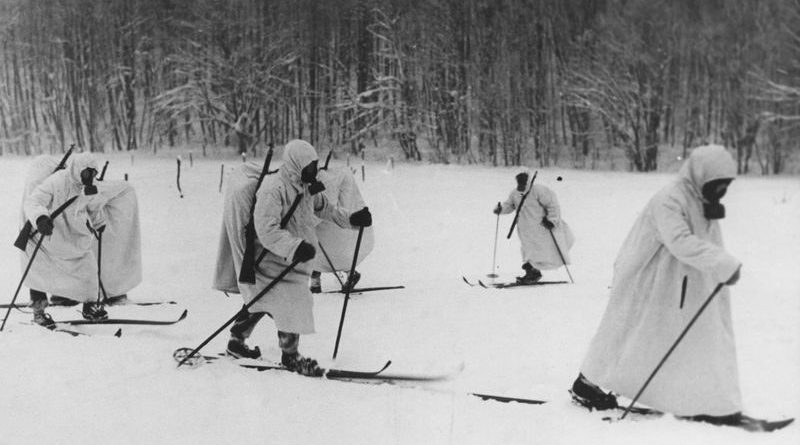What Ukraine Can Learn From Finland’s Stand 80 Years Ago
By Adm. James Stavridis, Dean Emeritus of the Fletcher School of Law and Diplomacy
The Winter War between the Finns and the Soviet Union has important parallels with the current conflict.
In November 1939, soon after Hitler’s Germany invaded Poland, another massive European country likewise attacked a smaller neighbor: Russia invaded Finland. After vicious fighting through a long and bitter winter, the war ended with the Moscow Peace Treaty, in which Finnish concessions fell far short of what Stalin had hoped for in launching his invasion.
Despite being heavily outgunned and outmanned by the Soviet Army, the Finns were able to largely fight the Russians to a standstill in what they call the Winter War. The scenario was eerily similar to the situation unfolding today in Ukraine, where President Vladimir Putin’s Russia is facing ferocious resistance from the scrappy Ukrainians.
Over a decade ago, when I visited Helsinki as the supreme allied commander of the North Atlantic Treaty Organization, the first place the Finns took me was to their Winter War Museum. We spent two hours there, and I was fascinated by the courage portrayed in the dioramas, exhibits, maps and photographs from the war. I treasure a gift the Finns gave me of a map showing the troop locations, and the names and faces of the Finnish generals around the border.
The Finns were outnumbered roughly two to one in terms of trained soldiers, but the more staggering differences were in tank and combat aircraft inventories. The Finns had just a few dozen of each, while the Soviets had around 5,000 tanks and 4,000 aircraft. Yet by the end of the conflict, the Finns had inflicted five times as many killed in action on the Soviet army as among their own.
While the Soviet advantages in the air and with mechanized operations eventually overcame much of the Finnish resistance, the determined nature of the defenders and the threat of an ongoing insurgency did much to shape the peace. Despite the pre-war goals of conquering the entire country and installing a puppet regime, the Soviets finally settled for a small slice of Finland’s territory (around 10%) and a pledge of Finnish neutrality.
What can we learn from the Russo-Finnish War that informs our approach to events in Ukraine today?
First and most importantly, we should appreciate that a determined military force, fighting on home terrain, can face down daunting odds to achieve success on the battlefield. The Finns have a long and fierce sense of independence, as do the Ukrainians, despite Russian protestations in both wars. I know firsthand the high quality of both nation’s militaries, which deployed under my command in Afghanistan and on other NATO missions.
When soldiers are fighting to protect their children, parents and spouses — and the independence of their nation — they have a significant morale advantage over conscripts and reservists. This was true for the Finns and remains a significant factor in the Ukraine war.
A second issue that applies in both instances is the importance of outside assistance. Volunteers from around the free world made their way to Finland to fight in the Winter War, notably from neighboring Sweden. The Finns received combat equipment and diplomatic assistance as well from many nations. The League of Nations condemned the Soviet invasion of Finland, much as the United Nations has censured Russia’s actions.
Increased outside assistance remains crucial for the Ukrainians, and the U.S. and its allies should intensify the level of sanctions on Russia and supply even more weapons than provided for in President Joe Biden’s new $800 million package. Additional Javelin and other anti-armor missiles, Stingers and similar weapons for anti-air warfare, Switchblade drones, machine guns, ammunition and rocket-propelled grenades are crucial. Ukraine is desperate for a long-range air-defense system, such as the Soviet-made S-300 that Slovakia has offered to send to Kyiv. The proposal to transfer MiG-29 fighter jets from Poland, which the U.S. quashed on March 9, should be revived.
Finally, the Western democracies need to think about how the war ends. While the ideal outcome would be a complete defeat for Putin and a humiliating withdrawal of all his forces from Ukraine, that appears unlikely — especially given the nuclear arsenal with which Russia can in effect blackmail the world.
Here the lesson of the Russo-Finnish War is that a diplomatic compromise may be necessary. Ukraine may have to provide a guarantee of neutrality and agree to give up some of the territory that is already de facto in the hands of Russia: Crimea and the Donbas region in the east.
In return, President Volodymyr Zelenskiy’s government would receive security guarantees — perhaps from the U.S. and the U.K., building on the Budapest Memorandum that Ukraine signed in 1994 when it gave up its nuclear weapons after the fall of the Soviet Union. (A document that has now proved worthless in the face of Russian aggression.)
This piece is republished from Bloomberg Opinion.

